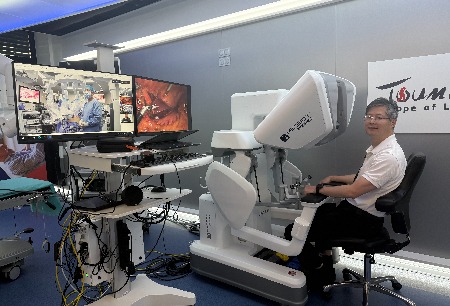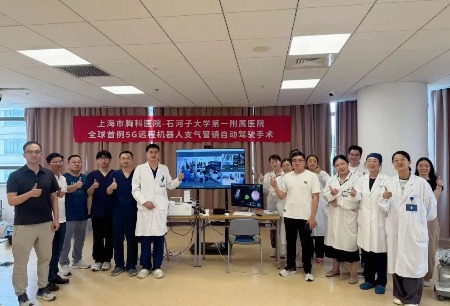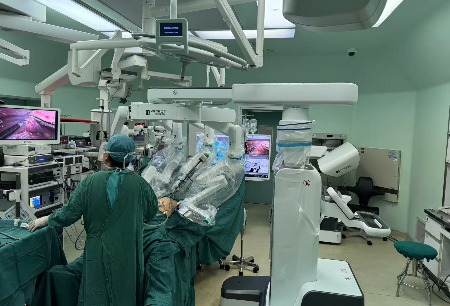Recently, Toumai® completed the first Chinese-developed 4-arm laparoscopic robot-assisted total intracavitary radical cystectomy & orthotopic neobladder at the First Affiliated Hospital, Zhejiang University School of Medicine (FAHZU). The entire procedure was performed in the abdominal cavity, which was tedious, complex and extremely difficult, making it one of the top urological operations. The operation was successfully completed by the team led by Prof. Shuo Wang and Prof. Ping Wang from the Urology Department of FAHZU. With its ergonomic, innovative design, and precise, stable performance, Toumai® helped surgeons overcome the challenges of long operation time and complex surgery. The successful completion of this difficult, complicated operation proves that Toumai® is one step further of being the leader of Chinese-developed laparoscopic surgery robot.
The patient was a male, over 70 years old, with a preoperative diagnosis of malignant bladder tumor. Prof. Shuo Wang's team analyzed the patient's basic physical condition and preoperative plan, and decided to perform a robotic-assisted total intracavitary radical cystectomy & orthotopic neobladder. The procedure was tedious and complicated. In addition to complete cystectomy, radical total cystectomy also requires pelvic lymph node dissection, including the lymphatic tissues of the common skeletal, internal and external iliac vessels and the paracentral lymph nerve, and intra-abdominal reconstruction of the ileocecal neo-vesical bladder and final suturing operation. It is a complex, lengthy procedure that requires a high degree of robotic experience and teamwork, as well as precision, stability and safety of the robot performance.
During the operation, the Toumai® Laparoscopic Surgical Robot, with its hands shaking filtering technology, effectively filtered the operator's hand shaking during the bilateral pelvic lymph node dissection stage, which greatly improved the precision and stability of the operation on deep and narrow areas and small tissues. During the cystectomy stage, the flexible, delicate surgical instruments of Toumai® assisted the primary surgeon to complete the large area of tissue retraction, freeing and cutting. In the ileal neobladder reconstruction stage, the high-definition immersive 3D images provided by Toumai® enables natural, deep recognition of the surgical area and assisted Prof. Shuo Wang in precise tissue identification and tissue level differentiation: intercepting the terminal ileum, marking the midpoint, precisely dissection, dissecting the intestinal canal, and then performing endpoint and midpoint anastomosis of the intestine. Finally, Prof. Ping Wang sutured the patient's new bladder and performed ureteral and urethral anastomosis to the ileum (new bladder) using the Toumai® high-freedom mechanical simulation wrist. In traditional bladder reconstruction, the assistant surgeon needs to pull the ileum outside the abdominal cavity for interception, dissection and suturing. In this surgery, the two professors used the robot to perform in-situ neobladder reconstruction inside the patient's abdominal cavity by controlling the robotic arm, which was very challenging and groundbreaking in the field of urological surgery. With the assistance of the Toumai® Laparoscopic Surgical Robot, Prof. Shuo Wang and Prof. Ping Wang completed the total intracavitary radical cystectomy & orthotopic neobladder in one go. The surgery successfully established a new urinary system for the patient, safeguarding the patient's life safety and quality while once again proving the safety and effectiveness of Toumai® in difficult, complex surgery.
On November 5, Toumai® completed the first 4-arm radical nephrectomy via retroperitoneal approach at the First Affiliated Hospital, Zhejiang University School of Medicine (FAHZU), which is also the ninth robotic-assisted difficult urological surgery performed by Toumai® since November, once again setting a new record in the field of urological surgery.
Also on November 5, during the opening ceremony of the 2022 Robot and Minimally Invasive Urological Surgery Forum, professor Shuo Wang completed the first live broadcasting of the radical prostatectomy via extraperitoneal approach assisted by Toumai®, and demonstrated the whole surgery process to the onsite audiences with textbook-like operation. The success of these surgeries indicated the outstanding skills of Prof. Shuo Wang’s team, and also verified the clinical adaptability and accurate assistance function of Toumai®. Based on the success experience of this surgery, Director Dan Xia and Director Shuo Wang from FAHZU will continue to promote the routine and normalized operation of this type of surgery. By continuously challenging highly difficult surgeries, the clinical operation level of the team and the post-operative experience of the patients may be improved, thus enabling more patients to enjoy the benefits brought by the Chinese-developed surgical robots.
Mr. Yu Liu, Executive Vice President and Chief Commercial Officer of MicroPort® MedBot®, said, "Laparoscopic total intracavitary radical cystectomy + orthotopic neobladder is a tedious, complicated procedure with long operation time, which puts high demands on the operator's experience and endurance, as well as product functions and performance. The successful completion of this surgery at FAHZU is another brand new achievement of Toumai® and even the whole Chinese-developed surgical robot field. Each successful surgery of MicroPort® MedBot® is the best proof the reliability, stability and safety of the product. Many a little makes a mickle. With the continuous progress of Toumai® in clinical practice and the continuous breakthrough in handling complex surgical procedures, Toumai® will become a powerful assistant for more and more surgeons, thus bringing benefits to more patients and realizing the original aspiration of ‘Make Surgery Easier, Safer and Less Invasive’”.
-
 2025-07-22Crossing 10,000 Kilometers: Toumai® Robot Performs World’s First Intercontinental Remote Liver Cancer Resection
2025-07-22Crossing 10,000 Kilometers: Toumai® Robot Performs World’s First Intercontinental Remote Liver Cancer Resection -
 2025-07-14MicroPort® MedBot™ Conducts World’s First 5G Remote Autopilot Robotic Bronchoscopy Cryoablation
2025-07-14MicroPort® MedBot™ Conducts World’s First 5G Remote Autopilot Robotic Bronchoscopy Cryoablation -
 2025-07-07World’s First LEO Satellite-Based Robotic Surgery Successfully Performed with Toumai® Mobile Surgical Platform
2025-07-07World’s First LEO Satellite-Based Robotic Surgery Successfully Performed with Toumai® Mobile Surgical Platform






 Hu ICP Bei No. 20013662 HGWA Bei No. 31011502015178
Hu ICP Bei No. 20013662 HGWA Bei No. 31011502015178 " are registered trademarks of Shanghai MicroPort Medical (Group) Co., Ltd.” . They have been authorized to be used by Shanghai Microport Medbot (Group) Co., Ltd., and no other party shall use such trademarks without prior written permission thereof.
" are registered trademarks of Shanghai MicroPort Medical (Group) Co., Ltd.” . They have been authorized to be used by Shanghai Microport Medbot (Group) Co., Ltd., and no other party shall use such trademarks without prior written permission thereof.
